check engine RENAULT TWINGO 2012 2.G User Guide
[x] Cancel search | Manufacturer: RENAULT, Model Year: 2012, Model line: TWINGO, Model: RENAULT TWINGO 2012 2.GPages: 220, PDF Size: 6.73 MB
Page 98 of 220
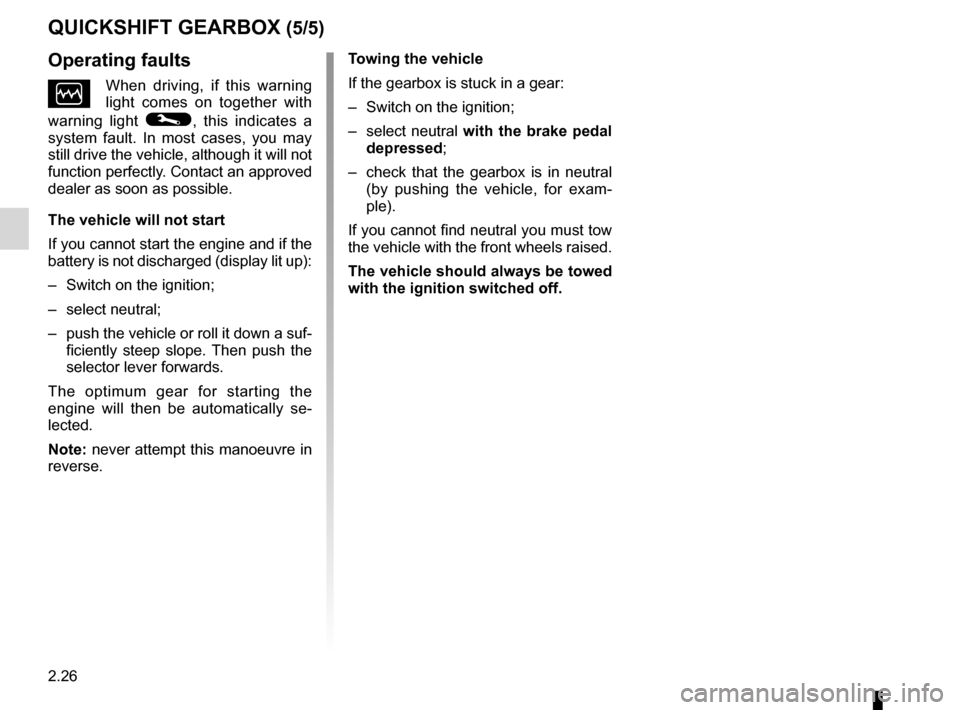
2.26
ENG_UD24716_6
Boîte de vitesses Quickshift (X44 - Renault)
ENG_NU_952-4_X44_Renault_2
QUIcKShIFt GeARBoX (5/5)
t owing the vehicle
If the gearbox is stuck in a gear:
– Switch on the ignition;
– select neutral with the brake pedal
depressed;
– check that the gearbox is in neutral
(by pushing the vehicle, for exam -
ple).
If you cannot find neutral you must tow
the vehicle with the front wheels raised.
the vehicle should always be towed
with the ignition switched off.operating faults
ÒWhen driving, if this warning
light comes on together with
warning light
©, this indicates a
system fault. In most cases, you may
still drive the vehicle, although it will not
function perfectly. Contact an approved
dealer as soon as possible.
the vehicle will not start
If you cannot start the engine and if the
battery is not discharged (display lit up):
– Switch on the ignition;
– select neutral;
– push the vehicle or roll it down a suf-
ficiently steep slope. Then push the
selector lever forwards.
The optimum gear for starting the
engine will then be automatically se -
lected.
Note: never attempt this manoeuvre in
reverse.
Page 106 of 220
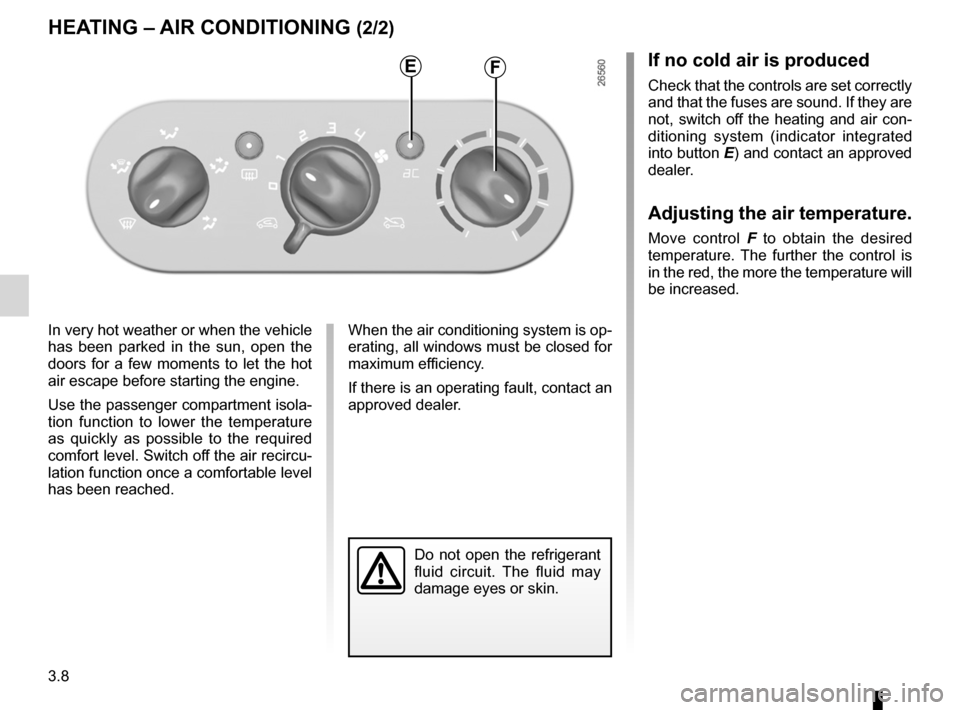
3.8
ENG_UD20167_4
Chauffage / air conditionné (X44 - Renault)
ENG_NU_952-4_X44_Renault_3
hEATINg – AIR CoNDITIoNINg (2/2)
In very hot weather or when the vehicle
has been parked in the sun, open the
doors for a few moments to let the hot
air escape before starting the engine.
Use the passenger compartment isola -
tion function to lower the temperature
as quickly as possible to the required
comfort level. Switch off the air recircu-
lation function once a comfortable level
has been reached. When the air conditioning system is op-
erating, all windows must be closed for
maximum efficiency.
If there is an operating fault, contact an
approved dealer.
If no cold air is produced
Check that the controls are set correctly
and that the fuses are sound. If they are
not, switch off the heating and air con-
ditioning system (indicator integrated
into button E) and contact an approved
dealer.
Adjusting the air temperature.
Move control
F to obtain the desired
temperature. The further the control is
in the red, the more the temperature will
be increased.
Do not open the refrigerant
fluid circuit. The fluid may
damage eyes or skin.
FE
Page 116 of 220
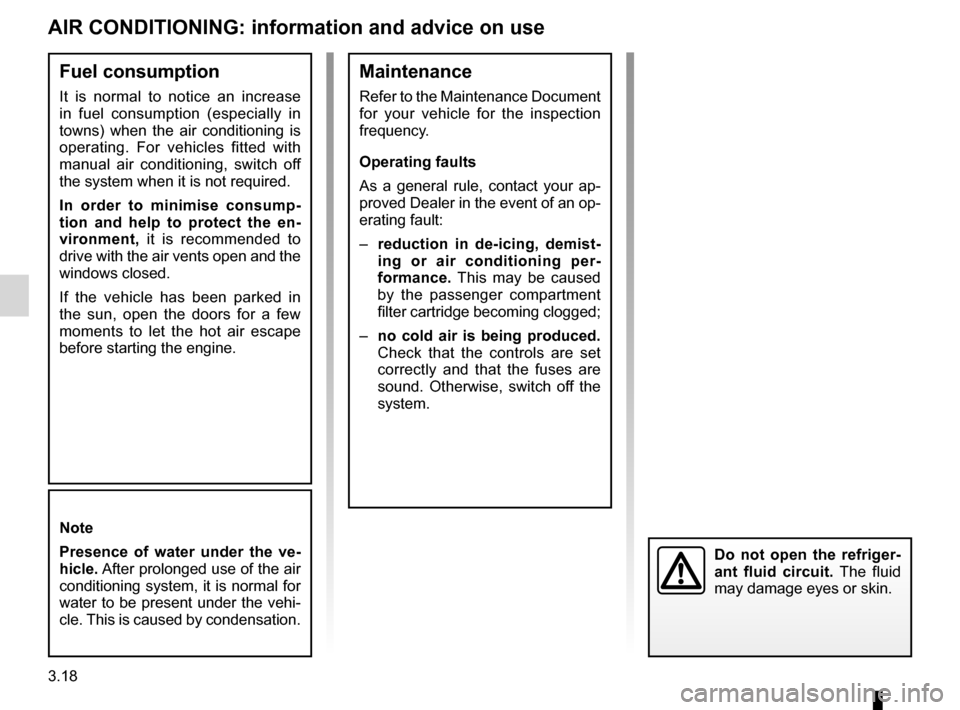
heating system ..................................... (up to the end of the DU)
air conditioning ..................................... (up to the end of the DU)
ventilation ............................................. (up to the end of the DU)
3.18
ENG_UD11090_2
Air conditionné : informations et conseils utilisation (X44 - Renaul\
t)
ENG_NU_952-4_X44_Renault_3
Air conditioning: information and advice on use
AIR CoNDITIoNINg: information and advice on use
Fuel consumption
It is normal to notice an increase
in fuel consumption (especially in
towns) when the air conditioning is
operating. For vehicles fitted with
manual air conditioning, switch off
the system when it is not required.
In order to minimise consump -
tion and help to protect the en -
vironment, it is recommended to
drive with the air vents open and the
windows closed.
If the vehicle has been parked in
the sun, open the doors for a few
moments to let the hot air escape
before starting the engine.
Maintenance
Refer to the Maintenance Document
for your vehicle for the inspection
frequency.
operating faults
As a general rule, contact your ap-
proved Dealer in the event of an op-
erating fault:
– reduction in de-icing, demist -
ing or air conditioning per -
formance. This may be caused
by the passenger compartment
filter cartridge becoming clogged;
– no cold air is being produced.
Check that the controls are set
correctly and that the fuses are
sound. Otherwise, switch off the
system.
Note
Presence of water under the ve -
hicle. After prolonged use of the air
conditioning system, it is normal for
water to be present under the vehi-
cle. This is caused by condensation.
Do not open the refriger -
ant fluid circuit. The fluid
may damage eyes or skin.
Page 141 of 220
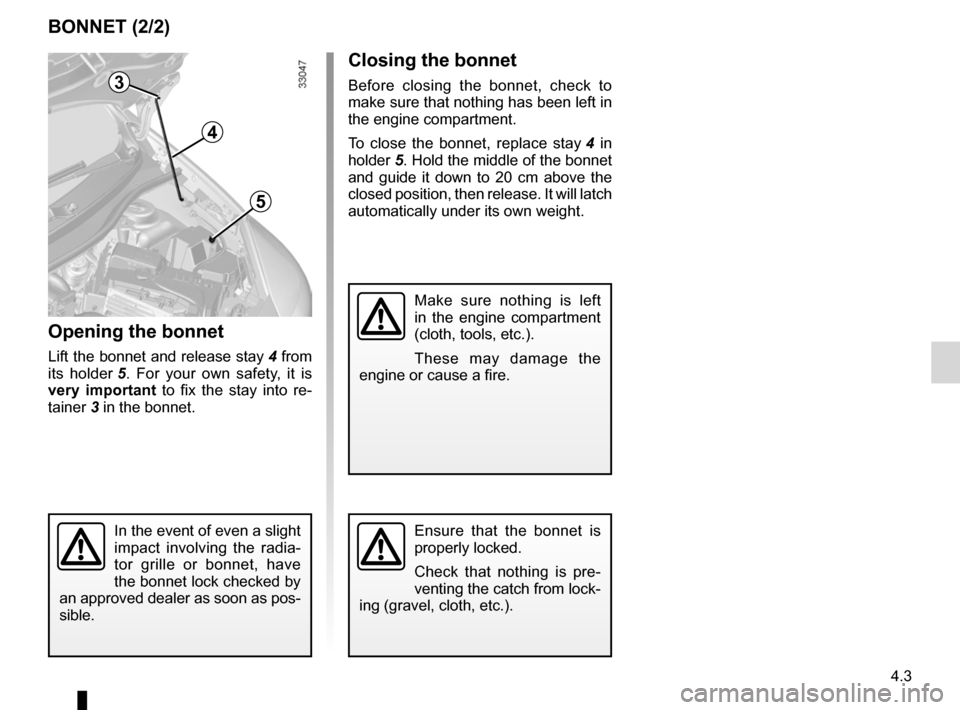
JauneNoirNoir texte
4.3
ENG_UD24707_5
Capot moteur (X44 - Renault)
ENG_NU_952-4_X44_Renault_4
BONNET (2/2)
Opening the bonnet
Lift the bonnet and release stay 4 from
its holder 5 . For your own safety, it is
very important to fix the stay into re -
tainer 3 in the bonnet.
Closing the bonnet
Before closing the bonnet, check to
make sure that nothing has been left in
the engine compartment.
To close the bonnet, replace stay 4 in
holder 5. Hold the middle of the bonnet
and guide it down to 20 cm above the
closed position, then release. It will latch
automatically under its own weight.
In the event of even a slight
impact involving the radia -
tor grille or bonnet, have
the bonnet lock checked by
an approved dealer as soon as pos-
sible.Ensure that the bonnet is
properly locked.
Check that nothing is pre -
venting the catch from lock-
ing (gravel, cloth, etc.).
5
3
4
Make sure nothing is left
in the engine compartment
(cloth, tools, etc.).
These may damage the
engine or cause a fire.
Page 142 of 220
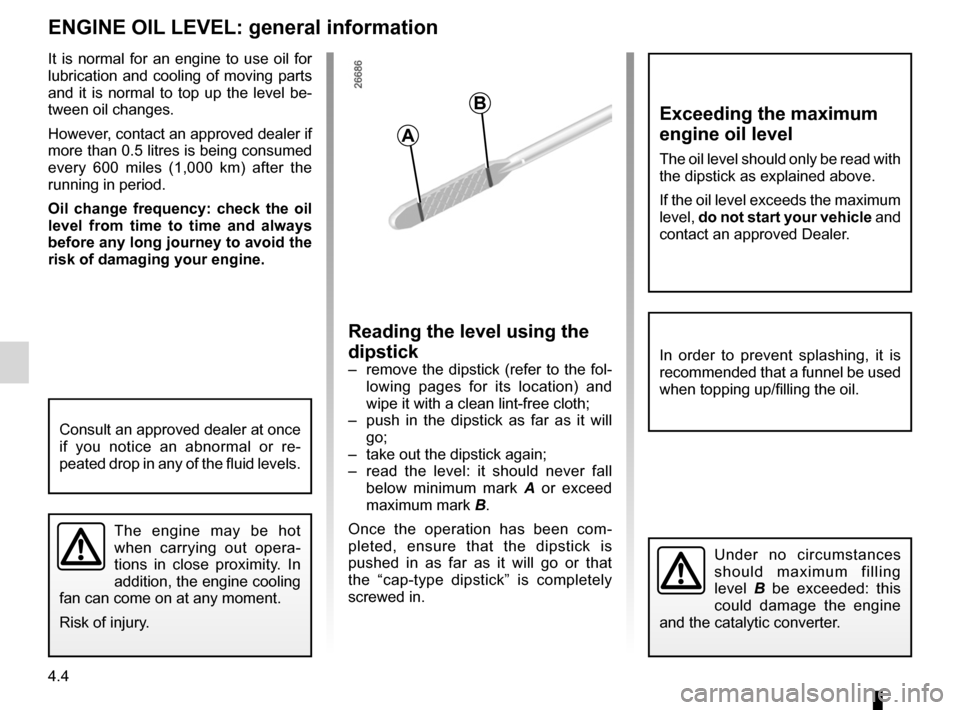
engine oil level ...................................... (up to the end of the DU)
engine oil .............................................. (up to the end of the DU)
dipstick.................................................. (up to the end of the DU)
engine oil capacity ................................ (up to the end of the DU)
maintenance: mechanical ...................................... (up to the end of the DU)
4.4
ENG_UD18936_3
Niveau huile moteur : généralités (X44 - Renault)
ENG_NU_952-4_X44_Renault_4
It is normal for an engine to use oil for
lubrication and cooling of moving parts
and it is normal to top up the level be-
tween oil changes.
However, contact an approved dealer if
more than 0.5 litres is being consumed
every 600 miles (1,000 km) after the
running in period.
Oil change frequency: check the oil
level from time to time and always
before any long journey to avoid the
risk of damaging your engine.
Engine oil level:
general information
ENGINE OIL LEVEL: general information
Consult an approved dealer at once
if you notice an abnormal or re -
peated drop in any of the fluid levels.
Exceeding the maximum
engine oil level
The oil level should only be read with
the dipstick as explained above.
If the oil level exceeds the maximum
level, do not start your vehicle and
contact an approved Dealer.
In order to prevent splashing, it is
recommended that a funnel be used
when topping up/filling the oil.
Reading the level using the
dipstick
– remove the dipstick (refer to the fol-
lowing pages for its location) and
wipe it with a clean lint-free cloth;
– push in the dipstick as far as it will
go;
– take out the dipstick again;
– read the level: it should never fall
below minimum mark A or exceed
maximum mark B.
Once the operation has been com -
pleted, ensure that the dipstick is
pushed in as far as it will go or that
the “cap-type dipstick” is completely
screwed in.
Under no circumstances
should maximum filling
level B be exceeded: this
could damage the engine
and the catalytic converter.
The engine may be hot
when carrying out opera -
tions in close proximity. In
addition, the engine cooling
fan can come on at any moment.
Risk of injury.
A
B
Page 143 of 220
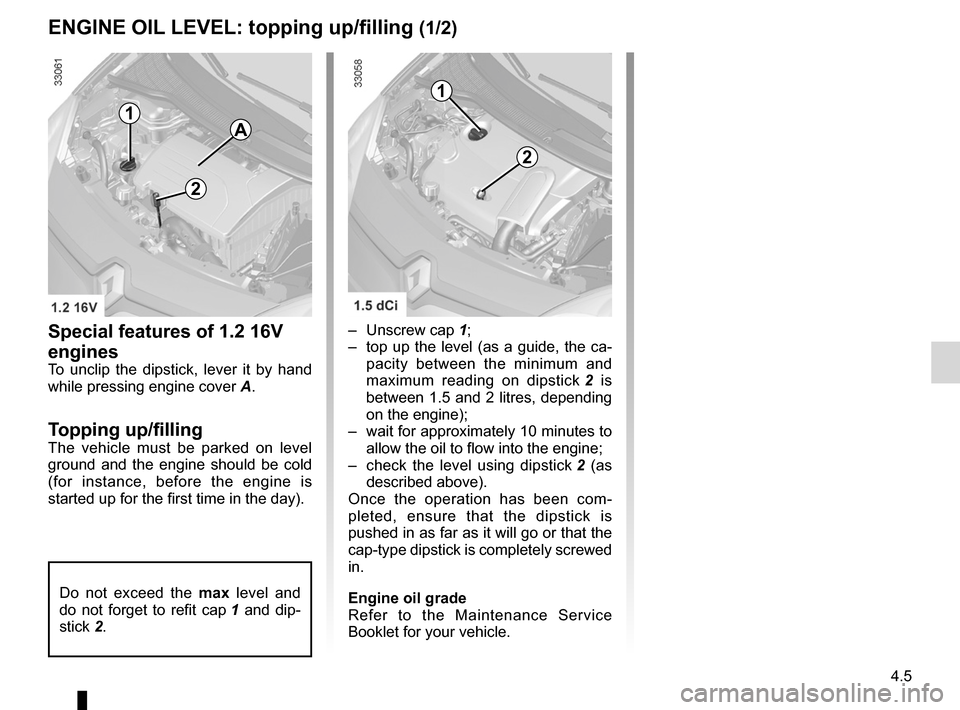
engine oil capacity ................................ (up to the end of the DU)
maintenance: mechanical ...................................... (up to the end of the DU)
engine oil .............................................. (up to the end of the DU)
dipstick.................................................. (up to the end of the DU)
levels: engine oil ........................................ (up to the end of the DU)
4.5
ENG_UD24736_5
Niveau huile moteur : appoint/remplissage (X44 - Renault)
ENG_NU_952-4_X44_Renault_4
topping up/filling
Special features of 1.2 16V
engines
To unclip the dipstick, lever it by hand
while pressing engine cover A.
Topping up/fillingThe vehicle must be parked on level
ground and the engine should be cold
(for instance, before the engine is
started up for the first time in the day). –
Unscrew cap 1;
– top up the level (as a guide, the ca-
pacity between the minimum and
maximum reading on dipstick 2 is
between 1.5 and 2 litres, depending
on the engine);
– wait for approximately 10 minutes to
allow the oil to flow into the engine;
– check the level using dipstick 2 (as
described above).
Once the operation has been com -
pleted, ensure that the dipstick is
pushed in as far as it will go or that the
cap-type dipstick is completely screwed
in.
Engine oil grade
Refer to the Maintenance Service
Booklet for your vehicle.
ENGINE OIL LEVEL: topping up/filling (1/2)
Do not exceed the max level and
do not forget to refit cap 1 and dip-
stick 2.
A1
2
1
2
Page 145 of 220
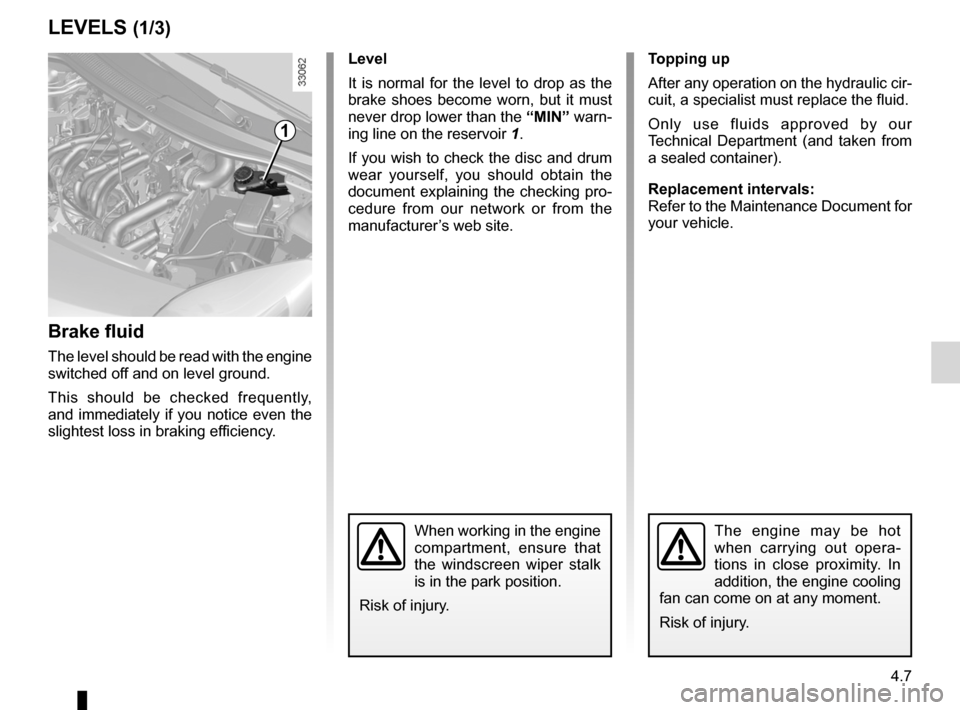
engine oil level ...................................... (up to the end of the DU)
engine oil .............................................. (up to the end of the DU)
brake fluid .............................................................. (current page)
4.7
ENG_UD24738_5
Niveaux / Filtres (X44 - Renault)
ENG_NU_952-4_X44_Renault_4
Levels:
Brake fluid
Topping up
After any operation on the hydraulic cir-
cuit, a specialist must replace the fluid.
Only use fluids approved by our
Technical Department (and taken from
a sealed container).
Replacement intervals:
Refer to the Maintenance Document for
your vehicle.
Brake fluid
The level should be read with the engine
switched off and on level ground.
This should be checked frequently,
and immediately if you notice even the
slightest loss in braking efficiency. Level
It is normal for the level to drop as the
brake shoes become worn, but it must
never drop lower than the
“MIN” warn-
ing line on the reservoir 1.
If you wish to check the disc and drum
wear yourself, you should obtain the
document explaining the checking pro-
cedure from our network or from the
manufacturer’s web site.
LEVELS (1/3)
When working in the engine
compartment, ensure that
the windscreen wiper stalk
is in the park position.
Risk of injury.The engine may be hot
when carrying out opera -
tions in close proximity. In
addition, the engine cooling
fan can come on at any moment.
Risk of injury.
1
Page 146 of 220
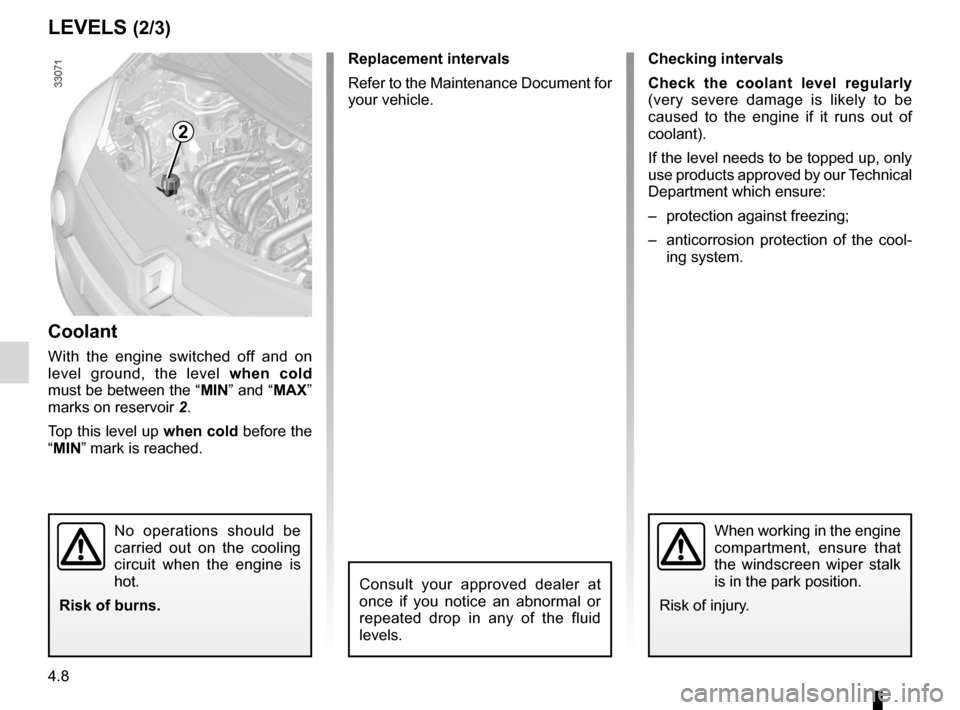
coolant ................................................................... (current page)
4.8
ENG_UD24738_5
Niveaux / Filtres (X44 - Renault)
ENG_NU_952-4_X44_Renault_4
Jaune NoirNoir texte
Engine coolant
LEVELS (2/3)
Coolant
With the engine switched off and on
level ground, the level when cold
must be between the “MIN” and “MAX”
marks on reservoir 2.
Top this level up when cold before the
“MIN” mark is reached. Replacement intervals
Refer to the Maintenance Document for
your vehicle.
Checking intervals
Check the coolant level regularly
(very severe damage is likely to be
caused to the engine if it runs out of
coolant).
If the level needs to be topped up, only
use products approved by our Technical
Department which ensure:
–
protection against freezing;
– anticorrosion protection of the cool -
ing system.
No operations should be
carried out on the cooling
circuit when the engine is
hot.
Risk of burns.When working in the engine
compartment, ensure that
the windscreen wiper stalk
is in the park position.
Risk of injury.
Consult your approved dealer at
once if you notice an abnormal or
repeated drop in any of the fluid
levels.
2
Page 178 of 220
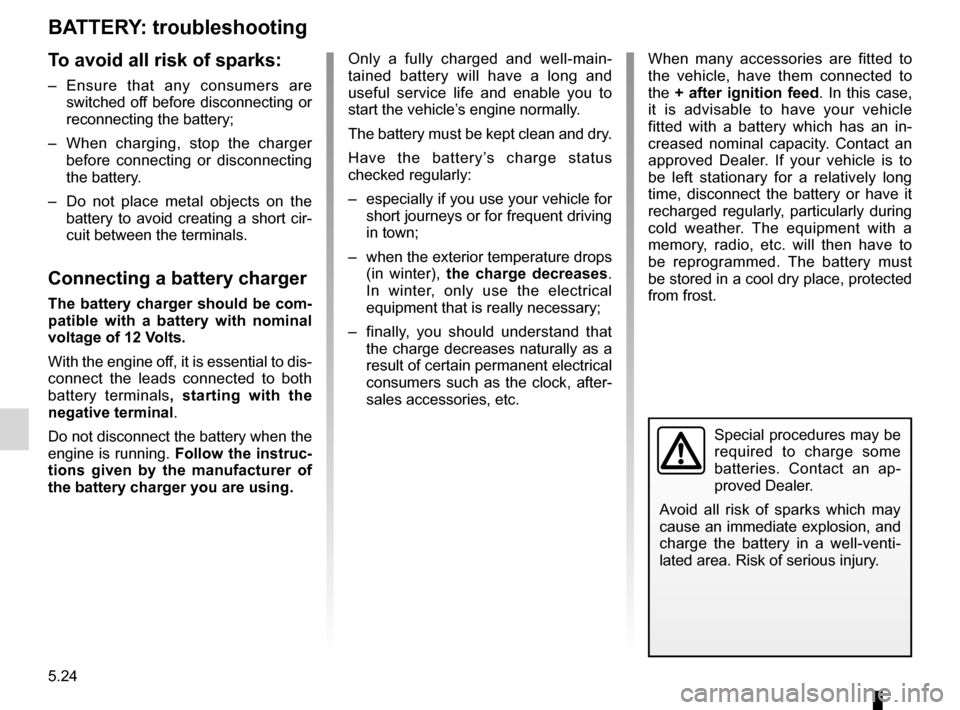
batterytroubleshooting ............................... (up to the end of the DU)
5.24
ENG_UD24705_3
Batterie : dépannage (X44 - Renault)
ENG_NU_952-4_X44_Renault_5
Jaune NoirNoir texte
Battery: troubleshooting
BAtter Y: troubleshooting
to avoid all risk of sparks:
– Ensure that any consumers are
switched off before disconnecting or
reconnecting the battery;
– When charging, stop the charger
before connecting or disconnecting
the battery.
– Do not place metal objects on the
battery to avoid creating a short cir-
cuit between the terminals.
connecting a battery charger
the battery charger should be com-
patible with a battery with nominal
voltage of 12 Volts.
With the engine off, it is essential to dis-
connect the leads connected to both
battery terminals , starting with the
negative terminal.
Do not disconnect the battery when the
engine is running. Follow the instruc-
tions given by the manufacturer of
the battery charger you are using. Only a fully charged and well
-main -
tained battery will have a long and
useful service life and enable you to
start the vehicle’s engine normally.
The battery must be kept clean and dry.
Have the battery’s charge status
checked regularly:
– especially if you use your vehicle for
short journeys or for frequent driving
in town;
– when the exterior temperature drops
(in winter), the charge decreases .
In winter, only use the electrical
equipment that is really necessary;
– finally, you should understand that
the charge decreases naturally as a
result of certain permanent electrical
consumers such as the clock, after-
sales accessories, etc.
When many accessories are fitted to
the vehicle, have them connected to
the + after ignition feed. In this case,
it is advisable to have your vehicle
fitted with a battery which has an in -
creased nominal capacity. Contact an
approved Dealer. If your vehicle is to
be left stationary for a relatively long
time, disconnect the battery or have it
recharged regularly, particularly during
cold weather. The equipment with a
memory, radio, etc. will then have to
be reprogrammed. The battery must
be stored in a cool dry place, protected
from frost.
Special procedures may be
required to charge some
batteries. Contact an ap -
proved Dealer.
Avoid all risk of sparks which may
cause an immediate explosion, and
charge the battery in a well-venti -
lated area. Risk of serious injury.
Page 179 of 220
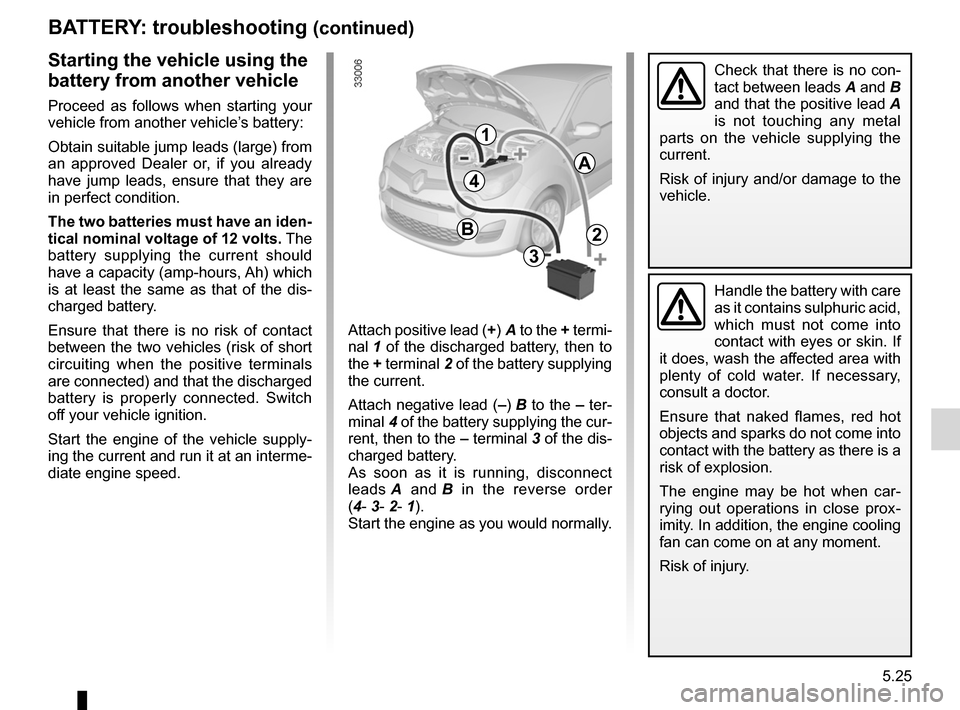
JauneNoirNoir texte
5.25
ENG_UD24705_3
Batterie : dépannage (X44 - Renault)
ENG_NU_952-4_X44_Renault_5
BA tter Y: troubleshooting (continued)
Starting the vehicle using the
battery from another vehicle
Proceed as follows when starting your
vehicle from another vehicle’s battery:
Obtain suitable jump leads (large) from
an approved Dealer or, if you already
have jump leads, ensure that they are
in perfect condition.
the two batteries must have an iden-
tical nominal voltage of 12 volts. The
battery supplying the current should
have a capacity (amp-hours, Ah) which
is at least the same as that of the dis-
charged battery.
Ensure that there is no risk of contact
between the two vehicles (risk of short
circuiting when the positive terminals
are connected) and that the discharged
battery is properly connected. Switch
off your vehicle ignition.
Start the engine of the vehicle supply -
ing the current and run it at an interme-
diate engine speed. Attach positive lead (+) A to the
+ termi-
nal 1 of the discharged battery, then to
the + terminal 2 of the battery supplying
the current.
Attach negative lead (–) B to the – ter-
minal 4 of the battery supplying the cur-
rent, then to the – terminal 3 of the dis-
charged battery.
As soon as it is running, disconnect
leads A and B in the reverse order
(4- 3- 2- 1).
Start the engine as you would normally.
A
B
1
4
2
3
Handle the battery with care
as it contains sulphuric acid,
which must not come into
contact with eyes or skin. If
it does, wash the affected area with
plenty of cold water. If necessary,
consult a doctor.
Ensure that naked flames, red hot
objects and sparks do not come into
contact with the battery as there is a
risk of explosion.
The engine may be hot when car -
rying out operations in close prox -
imity. In addition, the engine cooling
fan can come on at any moment.
Risk of injury.
Check that there is no con-
tact between leads A and B
and that the positive lead A
is not touching any metal
parts on the vehicle supplying the
current.
Risk of injury and/or damage to the
vehicle.